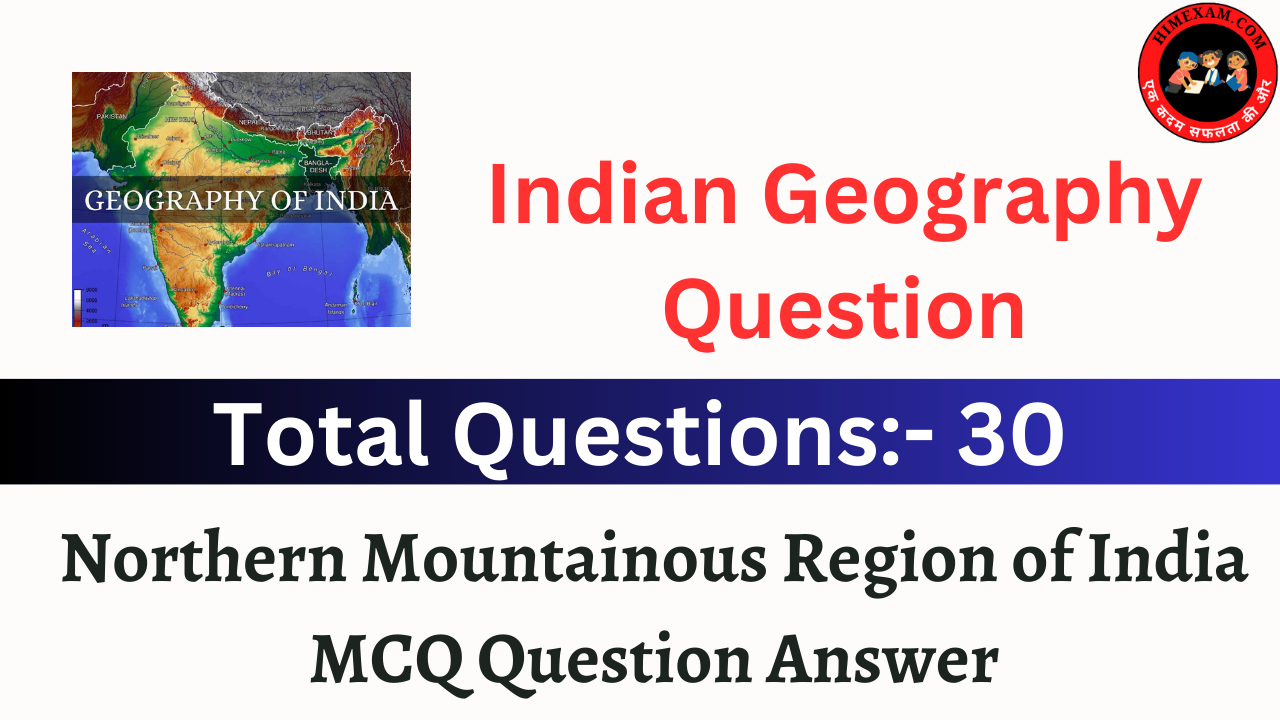Northern Mountainous Region of India MCQ Question Answer:-If you are preparing for any Himachal Pradesh government job paper then this post is very important for you. This post contains Northern Mountainous Region of India MCQ Question Answer In English. Check our website daily to see other parts.
Read More:-Bordering Countries Of India MCQ Question Answer
Northern Mountainous Region of India MCQ Question Answer
1. The Himalayas are formed of parallel fold ranges of which the oldest range is
(A) The Shivalik Range
(B) The Lesser Himalayas
(C) The Great Himalayan Range
(D) The Dhauladhar Range
2. The flat plains along the subHimalayan region in North India, are called
(A) Tarai
(B) Doon
(C) Khadar
(D) Bhabar
3. The foothills region of Himalayas is
(A) Trans – Himalayas
(B) Shivalik
(C) Greater Himalayas
(D) Aravali
4. Shivalik Hills are part of which of the following?
(A) Aravali
(B) Western Ghats
(C) Himalaya
(D) Satpura
5. Himachal stands for
(A) The Great Himalaya
(B) The Middle Himalaya
(C) Shivalik
(D) Trans-Himalaya
6. What is the height of Great Himalaya?
(A) 8850 m above sea level
(B) 8815 m above sea level
(C) 8890 m above sea level
(D) 8860 m above sea level
7. Shivalik series was formed in
(A) Eozoic
(B) Paleozoic
(C) Mesozoic
(D) Cenozoic
8. The altitude of Shivalik peaks fall in between
(A) 850-1200 m
(B) 750-1100 m
(C) 750-1500 m
(D) 750-1300 m
9. The South of ‘Shivalik’ rock series, Bhabar region is an example of
(A) Midland situation
(B) Intermountain situation
(C) Piedmont situation
(D) Littoral region
10. The Himalayan Mountain Ranges are not a part of which of the following states?
(A) Uttarakhand
(B) Uttar Pradesh
(C) Sikkim
(D) Himachal Pradesh
11. Main resources of Western Himalayan resource region, are
(A) Forests
(B) Metallic minerals
(C) Carbonic minerals
(D) Atomic minerals
12. Which of the following is a part of Aksai Chin region?
(A) Karakoram Range
(B) Shivalik Range
(C) Kashmir Valley
(D) Ladakh Plateau
13. The Lesser Himalaya is located between
(A) Trans Himalaya and Great Himalaya
(B) Shivalik and Great Himalaya
(C) Trans Himalaya and Shivalik
(D) Shivalik and Outer Himalaya
14. Which of the following is the correct order of the Himalayan Ranges from South to North in the Western section?
(A) Great Himalaya – Lesser Himalaya – Shivalik
(B) Shivalik – Lesser Himalaya – Great Himalaya
(C) Lesser Himalaya – Great Himalaya – Shivalik
(D) Shivalik – Great Himalaya – Lesser Himalaya
15. Which one of the following is the youngest mountain chain?
(A) Vindhyas
(B) Aravalli
(C) Shivaliks
(D) Anaimalai
16. Which of the following rock systems in India is the latest one?
(A) Vindhyan
(B) Cuddapah
(C) Dharwar
(D) Gondwana
17. Between which two mountain ranges is the Valley of Kashmir situated?
(A) Ladakh and Zanskar
(B) Great Himalayas and Pir Panjal
(C) Great Himalayas and Zanskar
(D) Karakoram and Ladakh
18. Which one of the following is the correct Northward sequence of the relief features?
(A) Zanskar Ranges, Pir Panjal Ranges, Ladakh Ranges, Karakoram Ranges
(B) Pir Panjal Ranges, Zanskar Ranges, Ladakh Ranges, Karakoram Ranges
(C) Karakoram Ranges, Ladakh Ranges, Zanskar Ranges, Pir Panjal Ranges
(D) Pir Panjal Ranges, Ladakh Ranges, Zanskar Ranges, Karakoram Ranges
19. Which one of the following groups is the correct sequence of mountain peaks from East to West?
(A) Everest, Kanchenjunga, Annapurna, Dhaulagiri
(B) Kanchenjunga, Everest, Annapurna, Dhaulagiri
(C) Kanchenjunga, Dhaulagiri, Annapurna, Everest
(D) Everest, Kanchenjunga, Dhaulagiri, Annapurna
20. In comparison to Eastern Himalaya the value of height of tree-line in Western area is
(A) More
(B) Less
(C) Same
(D) Unrelated variable
21. Pir Panjal Range is located/found in
(A) Arunachal Pradesh
(B) Jammu and Kashmir
(C) Punjab
(D) Uttarakhand
22. Which mountain range amongst the following is latest in origin?
(A) Ajanta range
(B) Palkonda range
(C) Kaimur Hills
(D) Patkoi ranges
23. Which one of the following states does not lie along Patkai hills?
(A) Nagaland
(B) Tripura
(C) Manipur
(D) Mizoram
24. Identify the correct West to East sequence of the following Hilly Castes.
(A) Khasi-Garo-Naga-Jaintia
(B) Naga-Jaintia-Khasi-Garo
(C) Garo-Khasi-Jaintia-Naga
(D) Jaintia-Naga-Garo-Khasi
25. Consider the following statements and select the correct answer from the code given below.
Assertion (A): All rivers originating from the Himalayas are perennial.
Reason (R): Himalayas receive much of their precipitation from South-Western monsoon.
Code
(A) Both (A) and (R) are true and (R) is the correct explanation of (A)
(B) Both (A) and (R) are true, but (R) is not the correct explanation of (A)
(C) (A) is true, but (R) is false
(D) (A) is false, but (R) is true
26. Consider the following statements and select the correct answer from the code given below.
Assertion (A): All rivers originating from the Himalayas are perennial.
Reason (R): Source of Himalayan rivers is located in glaciers.
Code
(A) Both (A) and (R) are true and (R) is the correct explanation of (A)
(B) Both (A) and (R) are true, but (R) is not the correct explanation of (A)
(C) (A) is true, but (R) is false
(D) (A) is false, but (R) is true
27. When you travel in Himalayas, you will see the following.
1. Deep gorges
2. U-turn river courses
3. Parallel Mountain ranges
4. Steep gradients causing landsliding
Which of the above can be said to be the evidences for Himalayas being young fold mountains?
(A) 1 and 2
(B) 1, 2 and 4
(C) 3 and 4
(D) 1, 2, 3 and 4
28. Consider the following relief features.
1. Zanskar Range
2. Dhauladhar Range
3. Ladakh Range
4. Karakoram Range
The correct South to Northward sequence of the above relief features is
(A) 2, 1, 3, 4
(B) 2, 3, 4, 1
(C) 4, 3, 2, 1
(D) 4, 2, 1, 3
29. In Himalayan Ranges the types of vegetation changes with altitude due to the following reasons.
1. Decrease in temperature
2. Changes in rainfall
3. Unfertile soil
4. Strong winds
Select the correct answer.
(A) 1, 2 and 3
(B) 2, 3 and 4
(C) 1, 3 and 4
(D) 1, 2 and 4
30. Consider the following statements.
1. In India, the Himalayas are spread over five States only.
2. Western Ghats are spread over five States only.
3. Pulicat Lake is spread over two States only.
Which of the statements given above is/are correct?
(A) Only 1 and 2
(B) Only 3
(C) Only 2 and 3
(D) Only 1 and 3
More Pages:-
हेलो दोस्तों ,आपका हमारी वेबसाइट Himexam.com पर स्वागत है। जैसा की आपको पता है हमारी वेबसाइट Himexam.com आपको समय-समय पर सभी HP Govt Jobs & All India Govt Jobs की Notifications प्रदान करवाती है। साथ ही साथ Himachal Pradesh Exam Previous Paper और Himachal Pradesh GK ,Himachal Pradesh & National +International Current Affairs के सभी नोट्स मुफ्त उपलब्ध करवाते है। हमारी वेबसाइट के अलग अलग प्लेटफार्म पर pages & Group बने है जैसे की facebook ,Telegram और Instagram .. अगर आप हिमाचल के किसी भी पेपर की तैयारी कर रहे हो तो जल्दी से इन groups के साथ जुड़ जाएं इनके लिंक नीचे table में दिए गए है।
Join Us:-
| Like Our Facebook Page | Click here |
| Join Us oN Telegram | Click here |
| Join Us On Instagram | Click Here |








